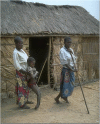Neuropsychological effects of konzo: a neuromotor disease associated with poorly processed cassava
- PMID: 23530166
- PMCID: PMC3608487
- DOI: 10.1542/peds.2012-3011
Neuropsychological effects of konzo: a neuromotor disease associated with poorly processed cassava
Abstract
Background: Konzo is an irreversible upper-motor neuron disorder affecting children dependent on bitter cassava for food. Although the neuroepidemiology of konzo is well characterized, we report the first neuropsychological findings.
Method: Children with konzo in the Democratic Republic of Congo (mean age 8.7 years) were compared with children without konzo (mean age 9.1 years) on the Kaufman Assessment Battery for Children, second edition (KABC-II), and the Bruininks-Oseretsky Test of Motor Proficiency, second edition (BOT-2). Both groups were also compared with normative KABC measures from earlier studies in a nearby nonkonzo region.
Results: Using a Kruskal-Wallis test, children with konzo did worse on the KABC-II simultaneous processing (visual-spatial analysis) (K [1] = 8.78, P = .003) and mental processing index (MPI) (K [1] = 4.56, P = .03) than children without konzo. Both konzo and nonkonzo groups had poorer KABC sequential processing (memory) and MPI relative to the normative group from a nonkonzo region (K [2] = 75.55, P < .001). Children with konzo were lower on BOT-2 total (K [1] = 83.26, P < .001). KABC-II MPI and BOT-2 total were predictive of konzo status in a binary logistic regression model: odds ratio = 1.41, P < .013; 95% confidence interval 1.13-1.69.
Conclusions: Motor proficiency is dramatically affected, and both children with and without konzo have impaired neurocognition compared with control children from a nonoutbreak area. This may evidence a subclinical neurocognitive form of the disease, extending the human burden of konzo with dramatic public health implications.
Figures



References
-
- Tylleskär T, Banea M, Bikangi N, Cooke RD, Poulter NH, Rosling H. Cassava cyanogens and konzo, an upper motoneuron disease found in Africa. Lancet. 1992;339(8787):208–211 - PubMed
-
- Banea-Mayambu JP, Tylleskär T, Gitebo N, Matadi N, Gebre-Medhin M, Rosling H. Geographical and seasonal association between linamarin and cyanide exposure from cassava and the upper motor neurone disease konzo in former Zaire. Trop Med Int Health. 1997;2(12):1143–1151 - PubMed
-
- World Health Organization. Konzo: a distinct type of upper motoneuron disease. Wkly Epidemiol Rec. 1996;71(30):225–232 - PubMed
-
- Tshala-Katumbay D, Eeg-Olofsson KE, Tylleskär T, Kazadi-Kayembe T. Impairments, disabilities and handicap pattern in konzo—a non-progressive spastic para/tetraparesis of acute onset. Disabil Rehabil. 2001;23(16):731–736 - PubMed
Publication types
MeSH terms
Grants and funding
LinkOut - more resources
Full Text Sources
Other Literature Sources
Medical

